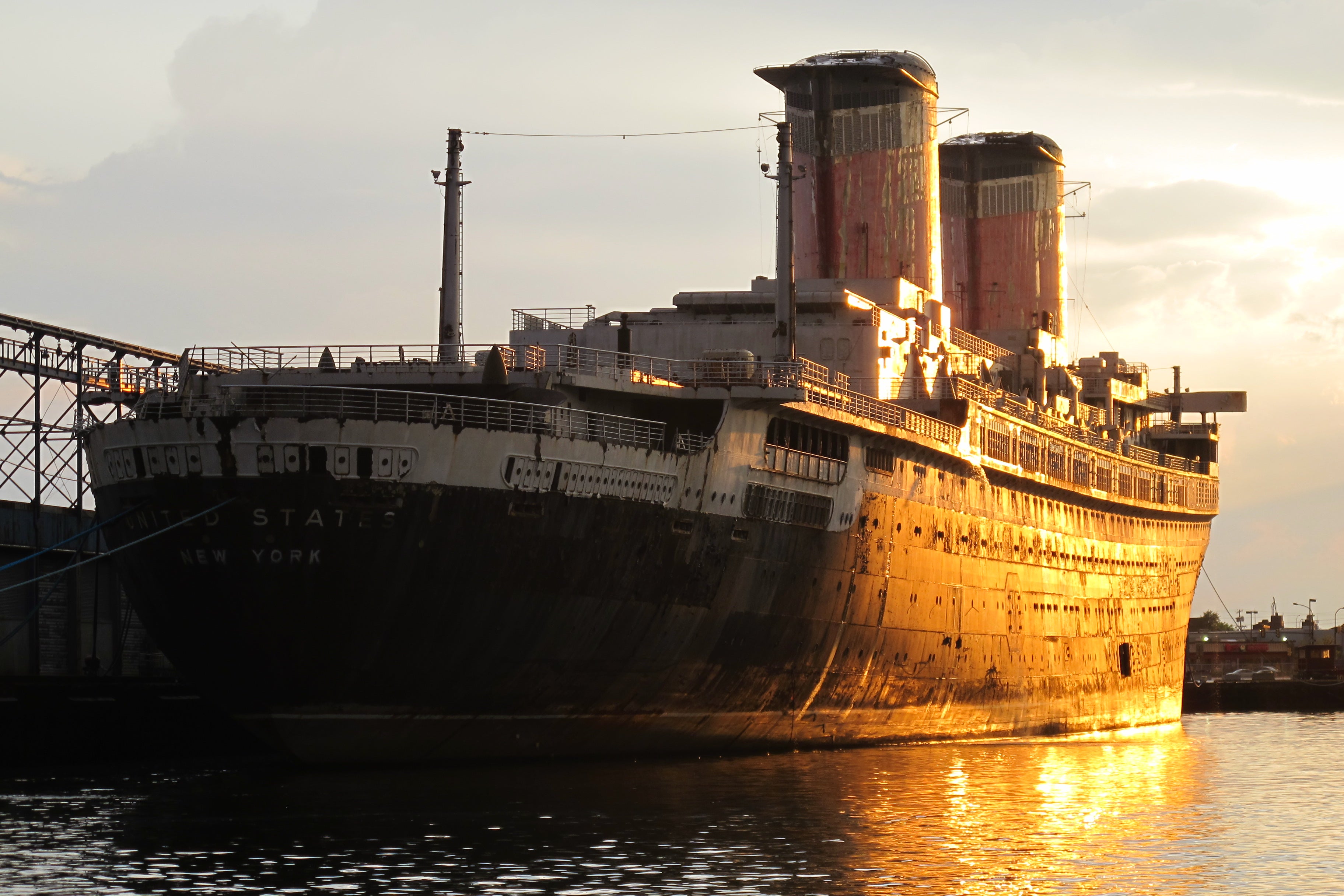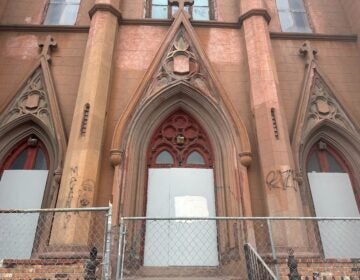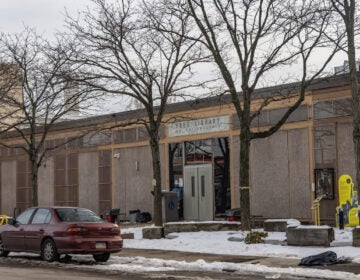The SS United States: Until the first blows fall

How best to describe the SS United States? Take the Chrysler Building, install engines powerful enough to drive an aircraft carrier, and outfit the inside with furnishings fit for John F. Kennedy and Princess Grace of Monaco. Then turn the skyscraper on its side, and push it through the rough waters of the North Atlantic at over forty miles per hour. This was the phenomenal American achievement of Philadelphia native William Francis Gibbs, docked on our city’s Delaware waterfront since 1996. Sixty years after the SS United States’ triumphant maiden voyage, the greatest ship ever built now sits as a faded, rusting shell of her former self in the city of her designer’s birth.
After decades of lay ups and reprieves, the clock may be running out on the ocean liner after 43 years of false hopes and miraculous rescues from the ship breaker’s torch. Gerry Lenfest’s $5.8 million grant gave SS United States 20 months of life (docking fees and maintenance) starting from the time of the ship’s purchase in February of last year. But if there is no real estate deal on the horizon for the ship to be converted into a waterfront attraction by November of this year, she will be pulled from her Philadelphia berth, towed to a beach in Texas, and torn apart for scrap. This would be an outrage comparable to the loss of New York’s Pennsylvania Station half a century ago, when The New York Times lamented, “Until the first blow fell, no one was convinced that Penn Station really would be demolished, or that New York would permit this monumental act of vandalism against one of the largest and finest landmarks of its age…”
As November approaches, Philadelphia and the nation are faced with a critical decision about the fate of an irreplaceable symbol of our nation’s past and one man’s astonishing vision. Until the first blows fall, we must be both realistic about the challenges facing the ship’s redevelopment and optimistic about her preservation for those who follow us.
Real estate deals — especially one as complex as redeveloping the SS United States— take time. In our era of big box, modular construction, she poses special challenges to a real estate developer. Unlike modern, land-based structures, the SS United States has a very idiosyncratic floor plan. But unlike the USS New Jersey and other preserved warships, she has big public rooms on her upper decks that can easily be converted into restaurant and entertainment space. Her original staterooms, small by today’s room standards, have been gutted, creating large open spaces on her lower decks that can be filled by guest rooms large enough to appeal to modern guests.
Yet ventilation shafts, funnel uptakes, and structural supports break up the floor plates, and she has few public rooms more than one deck in height. Her decks also have what is known as sheer: they slope upwards towards the bow and stern, meaning that new partitions, ceilings, and floors will have be custom-shaped to confirm with the ship’s unique interior space.
In the short term, the best way to save the SS United States is public support of the restoration in small, measureable increments, which could extend the period that she can stay tied up at her slip in Philadelphia. This physical redevelopment project is challenging by any standard, as is the complex public-private financing needed to convert her into a stationary waterfront attraction. At this juncture, small but tangible steps to preserve her, such as painting the funnels, would be a good way to show the public that progress is being made and their donations have had an impact. Realistically, the full cost of restoration and commercially successful rehabilitation could easily upwards of $250 million. In our tough economic times, it is highly unlikely that all of the money can be raised through public subscription or private development alone.
In the long term, in order to become a success as a paying real estate proposition, the SS United States needs the three things aside from the infusion of private capital by a development consortium:
- Partnership with a public or quasi-public entity that ensures the involvement of the municipality. This is essential considering the complexity of waterfront development in urban areas. Of course, public financing also mitigates the considerable risk a private developer takes in backing such an unusual, one-off project. The ship is also on the National Register of Historic Places, which makes the developer eligible for a 20% tax credit on hard development costs. According to the SS United States Conservancy, New York, Philadelphia, and Miami are possible future homes for the SS United States.
- Seamless integration into land-based development complex that complements the ship, providing additional hotel, retail, entertainment areas that cannot be accommodated onboard. Such a vision was presented in November 2010, when Stephen Varenhorst Associates unveiled a beautiful, imaginative plan for the ship as the center of a casino development on the “Foxwoods site” in South Philadelphia. Gerry Lenfest sponsored the plan and feasibility study.
- The SS United States has touched millions of lives: crewmembers, passengers, and those who admired the ship from afar in her glory days. She has a devoted group of fans, but there must be broad-based public support of the Conservancy’s preservation mission to fund the ship’s exterior restoration and museum plans. The SS Conservancy has recently launched a new public history initiative, SavetheUnitedStates.org, which allows people from all over the world to purchase sections of a digital ship and share their stories, films, and photographs.
What has kept the SS United States alive when by all practical purposes she should have been scrapped years ago? There is the economic fact that she is the only large U.S. flagged deep sea passenger ship left, allowing her to legally sail nonstop between two American ports. But now, it is highly unlikely that the ship will ever sail again – she would require far too many expensive modifications to make her economically competitive with today’s mega cruise ships.
The SS United States is also alive because of the romance and allure of the glamorous age she represents. But nostalgia alone rarely translates to dollars. But romance married to a hardheaded understanding of what the ship needs now can produce the many dollars the great ship has to have to survive.
Steven B. Ujifusa, a PlanPhilly contributor, is the author of A Man and His Ship: America’s Greatest Naval Architect and His Quest to Build the SS United States, published by Simon & Schuster this summer. He also serves on the Advisory Council of the SS United States Conservancy.
Watch Steven Ujifusa and learn more about the SS United States:
- One man follows his passion and sticks with it. A story of American achievement. Images courtesy of the Frank O. Braynard Collection and the Mariners’ Museum. A film by Sam Katz and Phil Katz of History Making Productions.
- Steven Ujifusa discusses the history of the SS United States on the PlanPhilly yacht cruise on August 1, 2012.
WHYY is your source for fact-based, in-depth journalism and information. As a nonprofit organization, we rely on financial support from readers like you. Please give today.






